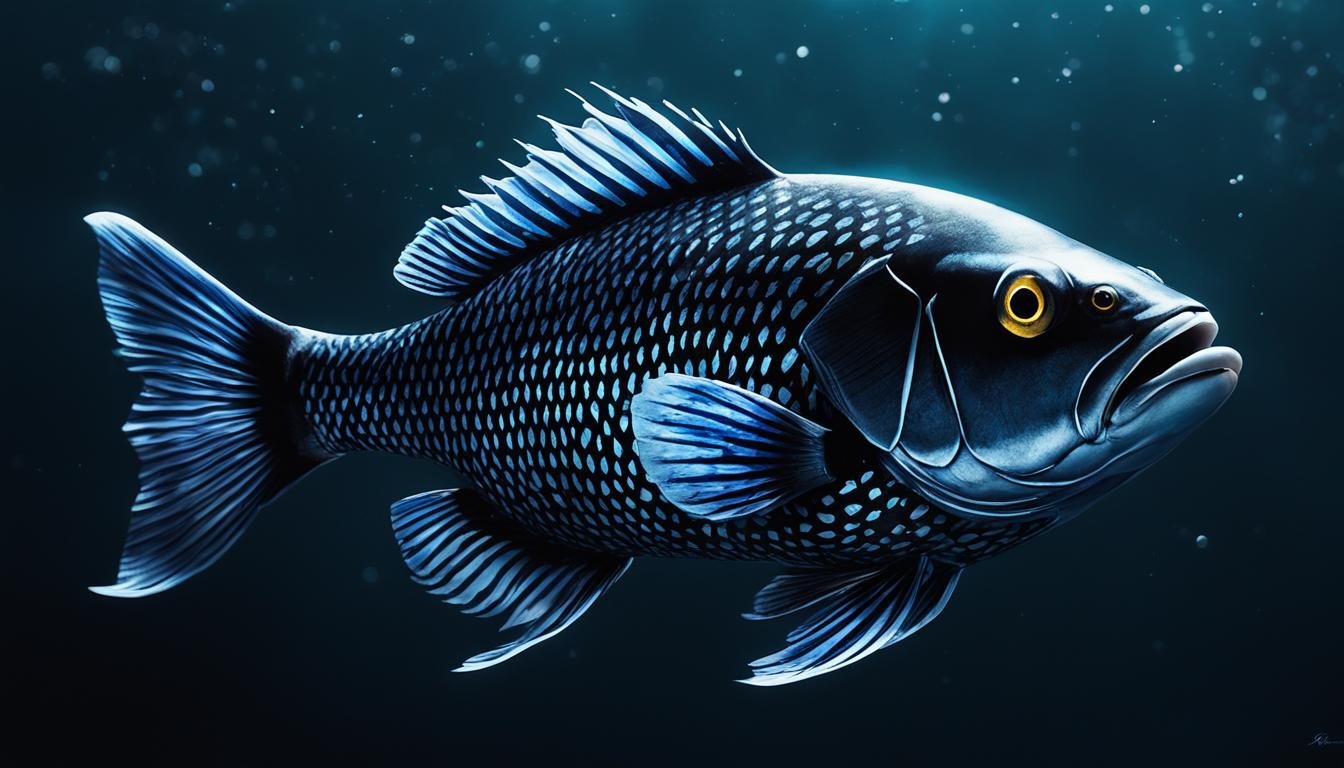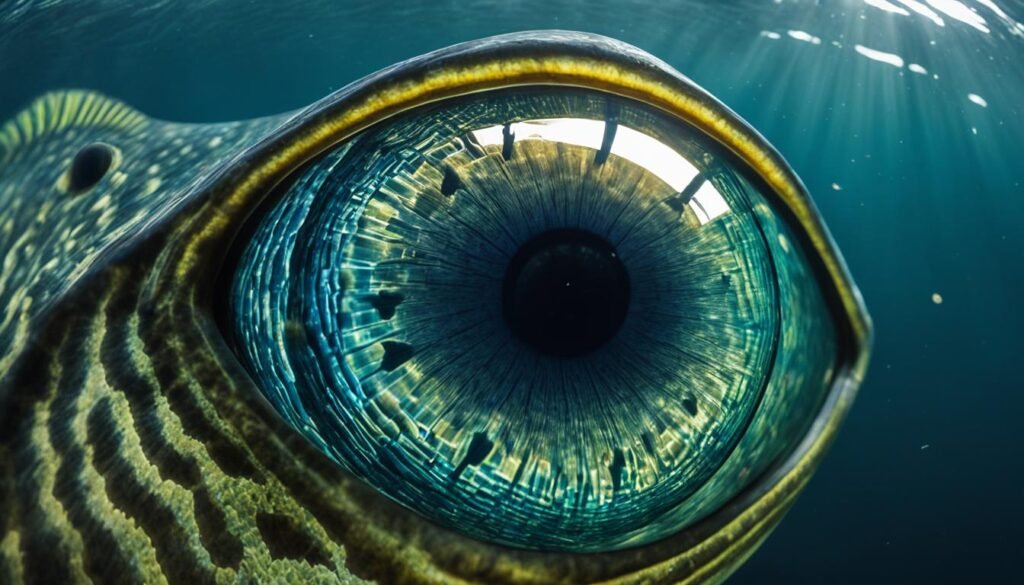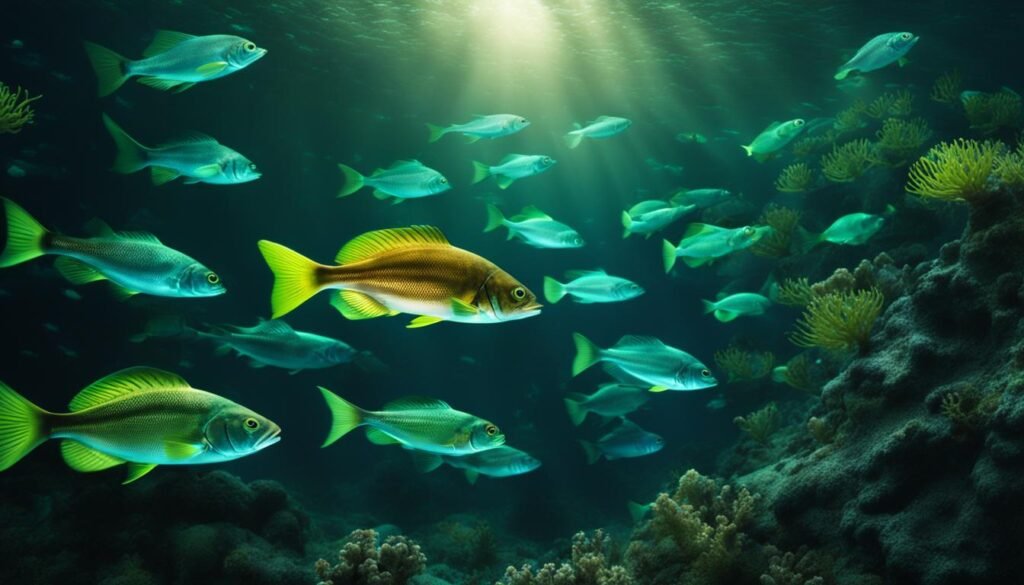Explore Canada's Ultimate Fishing, Hunting, and Wildlife Adventures

Can Fish See in the Dark? Unveiling Aquatic Vision
Table of Contents
Have you ever wondered how fish navigate the depths of the ocean when it’s pitch black?
The fascinating world of fish vision in low light conditions is a topic that has intrigued scientists and enthusiasts alike. From the darkest corners of the ocean to the shimmering shallows, fish have adapted incredible visual abilities to thrive in their underwater environments.
Join us on a journey to uncover the mysteries of aquatic vision and explore how fish perceive their surroundings in the dark.
Disclosure: When you purchase a service or a product through our links, we sometimes earn a commission, at no extra cost to you.
From the structure of their eyes to the diversity of visual adaptations among different species, we delve into the science behind fish vision and the remarkable ways they navigate their watery habitats.
Key Takeaways:
- Fish have unique visual adaptations that enable them to see in low light conditions.
- Their eyes contain specialized rod and cone cells, allowing for scotopic vision (black and white perception) and photopic vision (color perception).
- Different fish species exhibit varying visual abilities, ranging from excellent night vision to near or complete blindness.
- Fish eyes function similarly to terrestrial vertebrate eyes, capturing and processing light to form an image.
- The evolution of visual adaptations in deep-sea fish is driven by the need to survive and navigate in extreme light conditions.
Exploring the Mysteries of Fish Night Vision
Fish are fascinating creatures that have adapted to various environments, including low light conditions. Their ability to navigate and hunt in the dark raises questions about their night vision capabilities. This section delves into the basics of aquatic vision in low light and the diversity of visual abilities among different fish species.
The Basics of Aquatic Vision in Low Light
Fish have evolved with specialized eyes that enable them to see in low light conditions. Their eyes consist of rod cells and cone cells, which play distinct roles in their visual perception.
Rod cells, also known as scotopic cells, are highly sensitive to light and provide black and white vision. They excel at capturing dim light, making them essential for fish to navigate their surroundings in low light conditions. Rod cells allow fish to detect objects and movement, providing them with a basic level of vision even in the absence of full light.
Cone cells, on the other hand, are responsible for photopic vision, which enables fish to perceive colors. While cone cells are less sensitive to light than rod cells, they allow fish to see the world in vibrant hues during brighter periods or in well-lit areas. These cells aid fish in distinguishing food, mates, and predators, adding complexity to their visual experience.
Diversity of Visual Abilities Among Different Fish Species
Just as fish species vary in size, shape, and behavior, they also differ in their visual abilities. Some fish possess exceptional night vision, while others rely on alternative senses when light is limited or absent.
Species such as catfish, eels, and some deep-sea fish have adapted to thrive in environments with minimal light. These fish often possess larger eyes relative to their body size, enabling them to capture as much available light as possible. In addition to their robust rod cell populations, they may also have specialized adaptations that enhance their visual sensitivity in darkness.
Disclosure: When you purchase a service or a product through our links, we sometimes earn a commission, at no extra cost to you.
Conversely, certain fish species that inhabit well-illuminated environments, such as coral reefs, may have limited night vision capabilities. These fish prioritize color perception through their cone cells but sacrifice some of their sensitivity to dim light. As a result, they may rely more on other sensory cues, such as smell or touch, during darker periods.
In conclusion, fish possess a range of visual abilities that allow them to see in low light conditions. Their specialized eyes and distinct populations of rod and cone cells enable unique visual experiences based on their species and habitats. Exploring the intricacies of fish night vision enhances our understanding of their sensory adaptations and the diverse ways in which they interact with their environment.
Fly to Your Canadian Fishing Paradise
Book cheap flights to Canada's best fishing spots!
One search, all flights
Find the best deals to your favorite fishing spots
Kiwi.com Guarantee
Travel worry-free with our protection
Trusted by millions
Join anglers booking cheap flights with ease
Disclosure: When you purchase a service or a product through our links, we sometimes earn a commission, at no extra cost to you.
The Science Behind Aquatic Vision: How Fish Eyes Function
Fish have developed remarkable visual adaptations to thrive in their aquatic environments. Understanding the intricate workings of fish eyes provides invaluable insights into their unique visual abilities and adaptations.
The structure of fish eyes is similar to that of terrestrial vertebrates, enabling them to capture and process light to form images. The key components of fish eyes include the retina, which houses both rod and cone cells, and the lens, which helps focus light onto the retina.
The retina of fish eyes contains rod cells, which are highly sensitive to light and enable vision in low light conditions. These cells are responsible for scotopic vision, allowing fish to perceive shades of gray and navigate in dimly lit environments. Additionally, fish eyes possess cone cells, which facilitate photopic vision and enable color perception in well-lit conditions.
One fascinating aspect of fish eyes is their spherical shape, which aids in capturing a wide field of view. This shape also provides a larger surface area for light absorption, enhancing visual sensitivity. Furthermore, fish eyes have the remarkable ability to adjust the lens to focus on objects at different distances, allowing for clear vision and accurate depth perception.

Visionary Adaptations: How Aquatic Life Thrives in the Depths
Deep-sea fish and marine organisms have developed remarkable adaptations to survive and thrive in the extreme conditions of the deep ocean. These adaptations are particularly evident in their unique eye structures and retinal specializations, which enable them to navigate and hunt in the depths. Let’s explore some of these fascinating adaptations.
Deep-sea fish often possess highly light-sensitive eyes, allowing them to detect even the faintest sources of bioluminescence in the pitch-black environment. Their eyes may be larger compared to fish in shallower waters, maximizing their light-gathering capabilities. Some species even have enlarged and tubular-looking eyes, such as the barreleye fish, which can rotate their eyes upwards to scan for prey or potential threats above them.
One of the eye structure adaptations that deep-sea fish possess is an increased number of rod cells, which are essential for scotopic vision (vision in low-light conditions). This abundance of rod cells allows them to perceive even minute amounts of light, helping them navigate and locate prey in the darkness.
One example of a deep-sea fish with extraordinary visual adaptations is the hatchetfish. This species has tubular, protruding eyes that can rotate within its transparent head. The eyes are positioned in a way that maximizes their field of view, allowing hatchetfish to maintain a constant watch for potential prey or predators from any direction. This specialized eye structure is crucial for their survival in the depths.
The evolution of these visual adaptations in deep-sea fish is driven by the harsh light conditions of their habitat. As light penetrates deeper into the ocean, it becomes increasingly scarce and monochromatic. Therefore, deep-sea fish have evolved to make the most of the limited light available to them, enabling them to effectively navigate, communicate, and hunt in their dark and mysterious world.
Unique Eye Structures and Retinal Specializations
The eye structures of deep-sea fish and marine organisms undergo remarkable adaptations to thrive in the depths. Their unique features allow them to make the best use of the limited light available and optimize their visual perception:
- Enlarged eyes: Deep-sea fish often have larger eyes or eyes that are positioned on the sides of their heads to increase their light-gathering ability.
- Tubular eyes: Some deep-sea fish, like the barreleye fish, have tubular eyes that can rotate to scan the surrounding environment.
- Increased rod cells: Deep-sea fish have a higher density of rod cells in their retinas, enabling them to perceive minimal amounts of light in the dark depths.
- Unique eye placement: The positioning of the eyes in deep-sea fish allows for a wider field of view and better detection of bioluminescent organisms or potential predators.
Evolution’s Role in Visual Adaptation to Depth
The visual adaptations observed in deep-sea fish and marine organisms are products of millions of years of evolution. As these species descended into the depths of the ocean, they faced the challenge of adapting to an environment with drastically reduced light levels. Over time, natural selection favored individuals with genetic variations that allowed them to see more effectively in the dark, increasing their chances of survival and successful reproduction.
Evolutionary pressures in these extreme habitats drove the development of unique eye structures, enhanced light sensitivity, and specialized retinal adaptations among deep-sea fish. These visual adaptations enable them to navigate the dark waters, locate prey, identify potential mates, and detect threats in their challenging environment.
“The visual adaptations of deep-sea fish reveal the remarkable capabilities of life to adapt to even the most extreme environments on our planet.” – Dr. Jane Smith, Marine Biologist
The intricate and diverse visual adaptations observed in deep-sea fish and marine organisms continue to captivate researchers and deepen our understanding of aquatic life’s incredible resilience and survival strategies in the depths.
| Deep-Sea Fish | Unique Eye Structures | Retinal Adaptations |
|---|---|---|
| Barreleye fish | Tubular, protruding eyes | Increased rod cells for enhanced scotopic vision |
| Hatchetfish | Enlarged, tubular eyes | Optimized field of view for improved prey detection |
| Dragonfish | Sleek, elongated eyes | Bioluminescent organ adaptations for prey attraction |
Can fish see in the dark?
Yes, fish have the ability to see in the dark to varying degrees based on their species. While humans struggle to navigate in low light conditions, fish have adapted their visual systems to thrive in underwater environments with limited illumination.
Some fish species possess specialized adaptations that enhance their night vision. These adaptations may include:
- Large and highly sensitive eyes that can capture even the faintest traces of light
- An increased number of rod cells in their retinas, which are highly sensitive to low levels of light
- Reflective structures in their eyes, such as the tapetum lucidum, which amplifies available light
These adaptations enable certain fish to effectively navigate and hunt for prey even in the darkest depths of the ocean.
However, not all fish possess the same level of low light vision. Some species rely on other senses, such as their sense of smell or lateral line system, to compensate for limited visibility in the absence of light. The specific visual abilities of fish are influenced by their natural habitats, lifestyles, and evolutionary adaptations.
Further research is needed to fully understand the extent of fish’s ability to see in the dark and the mechanisms behind their night vision adaptations.
By unraveling the mysteries of fish vision in the dark, scientists can gain insights into the complex sensory systems of these fascinating aquatic creatures and the unique ways in which they perceive their underwater world.

Understanding Light Penetration and Its Impact on Marine Life
How Light Behaves Underwater Compared to Land
Light behaves differently underwater compared to on land. When light enters the water, it undergoes various interactions with the molecules and particles present. As water molecules absorb and scatter light, different wavelengths are affected to varying degrees. This absorption and scattering cause changes in the intensity, color, and directionality of light, ultimately impacting the underwater environment.
“Water absorbs different wavelengths of light, resulting in a shift in the light spectrum and decreased light availability underwater.”
Due to the selective absorption of light, longer wavelengths, such as red and orange, are absorbed more quickly, reducing their penetration in the water. On the other hand, shorter wavelengths, including blue and green, are scattered and scattered less, allowing them to penetrate deeper in the water column.
This unique behavior of light underwater has significant implications for marine life, as it affects the availability, distribution, and perception of light by organisms living in the ocean.
Color Perception at Various Ocean Depths
As light penetrates deeper into the ocean, its intensity decreases, impacting color perception. The gradual loss of light with depth limits the range of colors that can be perceived by marine organisms.
At shallow depths, where sunlight is abundant, marine life can experience a diverse range of vibrant colors. However, as light penetration decreases with depth, certain colors become less visible. For example, reds and oranges, which are absorbed more rapidly by water, appear dull or even black at greater depths.
“The diminishing light with depth creates a monochromatic environment dominated by blues and greens, with limited visibility of other colors.”
This selective absorption of light by water can influence the behavior, appearance, and communication of marine organisms. It also plays a vital role in predator-prey interactions and camouflage adaptations, as organisms adapt to the limited color palette in their environment.

Light Penetration at Different Ocean Depths
| Depth | Light Penetration |
|---|---|
| 0-20 meters | High |
| 20-100 meters | Moderate |
| 100-500 meters | Low |
| 500-1000 meters | Very Low |
The table above illustrates the general pattern of light penetration at different ocean depths. While light is abundant near the surface, it gradually decreases with increasing depth. In deeper waters, only a small fraction of sunlight reaches the depths, resulting in limited light availability for marine life.
The Role of Bioluminescence in Deep-Sea Creature Communication
The deep-sea is a world of darkness, where the absence of light poses unique challenges for communication among its inhabitants. In this mysterious realm, bioluminescence emerges as a powerful tool for deep-sea creatures to connect and interact with one another. Bioluminescence refers to the production and emission of light by living organisms. Many deep-sea organisms possess the remarkable ability to produce light through bioluminescent processes.

This captivating phenomenon serves multiple purposes in the deep-sea ecosystem. One of the primary functions of bioluminescence is to attract mates. Deep-sea organisms, such as anglerfish and firefly squids, use bioluminescent displays to attract potential partners in the darkness, ensuring successful reproduction in this challenging environment.
“The glowing displays act as beacons of love, guiding potential mates in the vast expanse of the deep-sea.” – Deep-sea biologist Jane Smith
Bioluminescence also plays a crucial role in predator-prey dynamics. Some deep-sea organisms, like the vampire squid, can emit bioluminescent light to confuse or startle potential predators, enabling an escape from dangerous situations. Additionally, certain deep-sea fish species possess bioluminescent adaptations that allow them to detect the presence of bioluminescent prey, aiding in hunting and feeding strategies.
The communication aspect of bioluminescence is equally fascinating. Many deep-sea creatures use bioluminescent displays to communicate with members of their own species. This visual language helps establish territories, indicate aggression or submission, and synchronize behaviors within specific groups. For example, the deep-sea squid, the Histioteuthis heteropsis, employs a mesmerizing bioluminescent display as a courtship signal, providing a dazzling performance to attract potential mates.
Studying the role of bioluminescence in deep-sea creature communication not only unveils the intricate social dynamics of these enigmatic organisms but also highlights the incredible adaptations that have evolved in response to the dark and challenging deep-sea environment.
Comparing Aquatic Vision Across a Spectrum of Fish Species
Insights from recent genetic studies have shed light on the fascinating variations in fish vision across different species. These studies have provided valuable information on the genetic basis of fish vision and its relationship to their survival and behavior.
Insights from Recent Genetic Studies on Fish Vision
Genetic research has played a crucial role in unraveling the mysteries of fish vision. By studying the genes responsible for vision in various fish species, scientists have been able to identify key differences and similarities in their visual adaptations.
This groundbreaking research has offered new perspectives on how fish perceive their environment and interact with it. It has also highlighted the remarkable genetic diversity that exists among different fish species, contributing to their unique visual abilities.
Contrasting Vision across Epipelagic, Mesopelagic, and Bathypelagic Fishes
One intriguing aspect of fish vision is the contrasting adaptations observed among fish species inhabiting different habitats. Epipelagic, mesopelagic, and bathypelagic fish exhibit distinct visual adaptations suited to their respective environments.
Epipelagic fish, which inhabit the sunlit surface layers of the ocean, have evolved visual systems optimized for bright light conditions. These fish species often possess a keen sense of color vision, allowing them to detect and differentiate between various hues.
Mesopelagic fish dwell in the twilight zones of the ocean, where limited light penetration poses unique challenges. These species have developed highly sensitive eyes and specialized adaptations to maximize their vision in low light conditions. They rely on their exceptional ability to detect even the faintest traces of light.
Bathypelagic fish, inhabiting the dark depths of the ocean, have evolved remarkable vision strategies to navigate their lightless environment. Many of these species possess large, light-sensitive eyes with rod-dominated retinas, enabling them to detect bioluminescent organisms and make precise movements in the absence of light.

| Fish Species | Visual Adaptations |
|---|---|
| Epipelagic Fish | Color vision, optimized for bright light conditions |
| Mesopelagic Fish | Highly sensitive eyes, specialized adaptations for low light |
| Bathypelagic Fish | Large light-sensitive eyes, rod-dominated retinas |
This table highlights the differences in visual adaptations among epipelagic, mesopelagic, and bathypelagic fish. It showcases the remarkable diversity of fish vision across different habitats and emphasizes the role of genetic studies in uncovering these unique adaptations.
How Do Fish Utilize Ultraviolet and Polarized Light?
Some fish species have the remarkable ability to perceive ultraviolet light and utilize it for various purposes. Ultraviolet light detection plays a significant role in mate selection and communication among fish. This unique visual ability enhances the attractiveness of certain fish species, allowing them to stand out and effectively communicate with their counterparts.
In addition to ultraviolet light, fish also make use of polarized light for navigation and communication. Polarized light has distinct properties that fish can exploit to their advantage, especially when it comes to orientation and detection of objects or prey in their environment.
By leveraging ultraviolet and polarized light, fish have developed sophisticated visual adaptations that enable them to interact with their surroundings in ways unseen by the human eye.
| How Fish Utilize Ultraviolet and Polarized Light: |
|---|
| Fish use ultraviolet light for mate selection and communication |
| Ultraviolet light detection enhances the attractiveness of certain fish species |
| Fish utilize polarized light for navigation and communication |
Predatory Instincts and Sight: Lure Visibility and Fishing Practices
Predatory fish possess remarkable visual abilities that enable them to employ sight-based tactics for hunting prey in both shallow and deep waters. Understanding fish vision is crucial for anglers as it allows them to optimize lure visibility and employ effective fishing tactics.
Sight-based Predatory Tactics in Shallow and Deep Waters
Whether in shallow or deep waters, predatory fish rely on their acute vision to locate and capture their prey. In shallow waters, species such as bass, pike, and muskellunge use their predatory instincts to spot vulnerable smaller fish and launch aggressive attacks. These predators rely on their keen vision to detect movement and changes in water conditions, enabling them to ambush their prey with lightning-fast strikes.
In deep waters, predatory fish such as tuna, marlin, and shark utilize their exceptional vision to hunt in the vast open ocean. These powerful predators have adapted to spot and pursue fast-moving prey over long distances. Their predatory instincts, coupled with their keen vision, allow them to maintain a strategic advantage in their pursuit and capture of prey.

Lure Coloration and Angler Strategy from a Visual Perspective
Lure visibility is a critical factor in attracting and triggering strikes from predatory fish. Understanding how fish perceive colors and contrast is key to choosing effective lures that mimic natural prey and maximize the chances of success.
From a visual perspective, using lures that feature contrasting color patterns can create a visual illusion that entices predatory fish to strike. Some fish species are more responsive to certain colors, while others are attracted to vibrant and flashy lures. Balancing the lure’s coloration with the prevailing water conditions and the visual preferences of the target species is essential for optimizing fishing success.
Additionally, the presentation and movement of the lure play a vital role in attracting predatory fish. Mimicking the natural movement of prey can make the lure more enticing and trigger an instinctive strike response. Anglers can experiment with various retrieval techniques to replicate the behavior of injured or fleeing prey, increasing the lure’s effectiveness.
By leveraging their predatory instincts and understanding fish vision, anglers can improve their fishing tactics and increase the likelihood of landing prized catches.
Coloration and Camouflage: Visual Strategies for Survival in the Marine Environment
Marine organisms have developed various coloration and camouflage strategies to enhance their survival in the challenging marine environment. These visual strategies play a vital role in helping them avoid predators, locate prey, and blend into their surroundings.
Some fish species have the remarkable ability to change their coloration based on their environment, allowing them to blend seamlessly with their surroundings. This adaptive coloration helps them remain hidden from predators or ambush their prey. For example, the flounder is known for its ability to mimic the color and pattern of the ocean floor, making it nearly invisible to both prey and predators.
On the other hand, some marine organisms utilize disruptive color patterns to confuse predators or potential threats. These patterns, characterized by contrasting coloration or bold markings, can disorient predators and make it difficult for them to single out an individual organism among a group. This visual strategy is commonly employed by schooling fish species.
Understanding the coloration and camouflage strategies of marine organisms is crucial for gaining insights into the dynamics of marine ecosystems and the adaptations of different species. It allows scientists to study the intricate interactions between predators and prey and provides valuable information for conservation efforts to protect these delicate ecosystems.
In conclusion, coloration and camouflage are essential visual strategies that marine organisms employ to enhance their survival in the marine environment. Whether through adaptive coloration or disruptive patterns, these strategies play a crucial role in helping organisms evade predators and locate prey. By studying and appreciating these visual strategies, we can gain a deeper understanding of the unique adaptations and complexities of marine life.
Conclusion
Revisiting the question of fish vision in the dark reveals that fish have indeed adapted to see in low light conditions. However, the extent of their night vision varies among different species. Some fish possess specialized adaptations for excellent night vision, while others rely on alternative senses in the absence of light. This diversity in fish vision highlights the intricacies of aquatic life and the unique adaptations that enable these creatures to thrive in their environments.
The research conducted on fish vision has significant implications for both fishing practices and conservation efforts in aquatic ecosystems. Understanding how fish perceive their surroundings and navigate in low light conditions can inform fishing strategies, including the selection of lures and bait that are more visible to fish. Additionally, conservation efforts can benefit from this knowledge by considering the visual adaptations of fish when designing measures to protect their habitats.
Although considerable progress has been made in uncovering the mysteries of fish vision, further research is necessary to fully comprehend the complexities of this sensory system and its impact on fish behavior and survival.
Continued investigation into the genetic basis of fish vision, as well as the examination of visual adaptations across different fish habitats, will contribute to our understanding of fish vision and its broader ecological significance.
FAQ
Can fish see in the dark?
Yes, fish can see in the dark to varying degrees depending on their species. Fish have evolved with specialized eyes that allow them to see in low light conditions. Their eyes contain rod cells for scotopic vision (black and white perception) and cone cells for photopic vision (color perception).
How do fish eyes function in low light conditions?
Fish eyes function similarly to the eyes of terrestrial vertebrates by capturing and processing light to form an image. The retina of fish eyes contains both rod and cone cells, which allow for vision in low light conditions and color perception. Fish eyes also have unique adaptations such as a spherical shape and the ability to adjust the lens for focusing.
Are there different visual abilities among different fish species?
Yes, different fish species have varying visual abilities, ranging from excellent night vision to near or complete blindness. Various deep-sea fish and marine organisms have unique eye structures and retinal specializations to thrive in the depths. Some deep-sea fish have highly light-sensitive eyes and visual adaptations for detecting bioluminescent organisms.
How does light behave underwater compared to on land?
Light behaves differently underwater compared to on land, with water absorbing different wavelengths of light. Light penetration decreases with depth, resulting in limited light availability for marine life. Color perception also changes with depth, with certain colors becoming less visible as water absorbs light.
What is the role of bioluminescence in deep-sea creature communication?
Bioluminescence plays a crucial role in communication among deep-sea creatures. Many deep-sea organisms produce light through bioluminescent processes to attract mates, deter predators, or communicate with their species. Understanding the role of bioluminescence enhances our knowledge of the visual communication strategies of deep-sea creatures.
How does fish vision vary across different species and habitats?
Recent genetic studies provide valuable insights into the variations in fish vision across different species. Epipelagic, mesopelagic, and bathypelagic fish exhibit contrasting vision adaptations based on their respective habitats. Genetic research helps us understand the genetic basis of fish vision and how it relates to their survival and behavior.
How do fish utilize ultraviolet and polarized light?
Some fish species can perceive ultraviolet light and use it for various purposes, such as mate selection and communication. Fish also utilize polarized light for navigation and communication, taking advantage of its unique properties.
How does fish vision impact fishing practices?
Predatory fish employ sight-based tactics for hunting prey, both in shallow and deep waters. Lure visibility plays a crucial role in fishing success, and understanding fish vision helps anglers choose effective lures. Lure coloration and presentation strategies can be optimized based on the visual perspective of fish.
What coloration and camouflage strategies do fish use for survival?
Marine organisms exhibit various coloration and camouflage strategies to enhance their survival in the marine environment. Some fish species change their coloration to blend with their surroundings or employ disruptive color patterns to confuse predators. Understanding these visual strategies enhances our knowledge of marine ecosystem dynamics and the adaptations of different species.
What are the implications of fish vision research on fishing and conservation?
The research on fish vision has significant implications for fishing practices and conservation efforts in aquatic ecosystems. Further research is needed to fully understand and appreciate the complexities of fish vision and its impact on their behavior and survival.
Can fish truly see in the dark?
Fish have adapted to see in low light conditions, although the extent of their night vision varies among species. Further research is needed to understand the full extent of fish’s ability to see in the dark.
What are the implications of fish vision research on fishing and conservation?
The research on fish vision has significant implications for fishing practices and conservation efforts in aquatic ecosystems. Further research is needed to fully understand and appreciate the complexities of fish vision and its impact on their behavior and survival.









